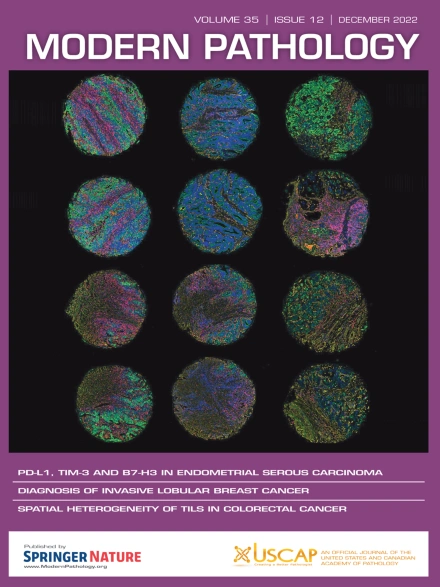Ex Vivo Fluorescence Confocal Microscopy for Intraoperative Evaluations of Staple Lines and Surgical Margins in Specimens of the Lung—A Proof-of-Concept Study
IF 7.1
1区 医学
Q1 PATHOLOGY
引用次数: 0
Abstract
Intraoperative consultation is frequently used during the surgical treatment of lung tumors for the diagnosis of malignancy and the assessment of surgical margins. The latter is often problematic given the nature of applied staple lines, which cannot be readily examined in frozen sections. Seventy-nine samples of surgical margins (71 staple lines and 8 open margins) from 52 lung specimens were examined using an ex vivo fluorescence confocal microscope (FCM). The diagnoses of the FCM scans were compared with the corresponding paraffin section images of the same material. The procedure provided intraoperative FCM imaging of the surgical margins and staple lines without having to remove the metal clips. Tumor-involved open margins (5/5) and tumor-involved staple lines (3/4) were correctly identified in the FCM images. The results also provided additional information to the conventional frozen sections (FS). To our knowledge, this is the first time staple lines of lung specimens have been visualized as preserved tissue using FCM. The method potentially provides an additional approach for intraoperative decisions when the margins in conventional frozen sections are unclear. Our promising results, however, need to be validated on a larger number of cases.
离体荧光共聚焦显微镜术中评估肺标本的主要线和手术边缘-一项概念验证研究
术中会诊是肺肿瘤手术治疗中常用的诊断恶性肿瘤和评估手术切缘的方法。后者通常是有问题的,因为所应用的订书钉线的性质不能在冷冻部分中轻易检查。采用体外荧光共聚焦显微镜(FCM)对52例肺标本的79个手术缘标本(71个缝合缘和8个开放缘)进行了检查。将FCM扫描的诊断结果与相同材料的石蜡切片图像进行比较。该方法无需移除金属夹即可提供术中手术缘和钉线的FCM成像。FCM图像正确识别肿瘤受累的开缘(5/5)和肿瘤受累的钉线(3/4)。结果也为常规冷冻切片提供了额外的信息。这是第一次使用流式细胞术将肺标本的主要线作为保存组织可视化。当常规冷冻切片的边缘不清楚时,该方法可能为术中决策提供额外的方法。然而,我们有希望的结果需要在更多的病例中得到验证。
本文章由计算机程序翻译,如有差异,请以英文原文为准。
求助全文
约1分钟内获得全文
求助全文
来源期刊

Modern Pathology
医学-病理学
CiteScore
14.30
自引率
2.70%
发文量
174
审稿时长
18 days
期刊介绍:
Modern Pathology, an international journal under the ownership of The United States & Canadian Academy of Pathology (USCAP), serves as an authoritative platform for publishing top-tier clinical and translational research studies in pathology.
Original manuscripts are the primary focus of Modern Pathology, complemented by impactful editorials, reviews, and practice guidelines covering all facets of precision diagnostics in human pathology. The journal's scope includes advancements in molecular diagnostics and genomic classifications of diseases, breakthroughs in immune-oncology, computational science, applied bioinformatics, and digital pathology.
 求助内容:
求助内容: 应助结果提醒方式:
应助结果提醒方式:


